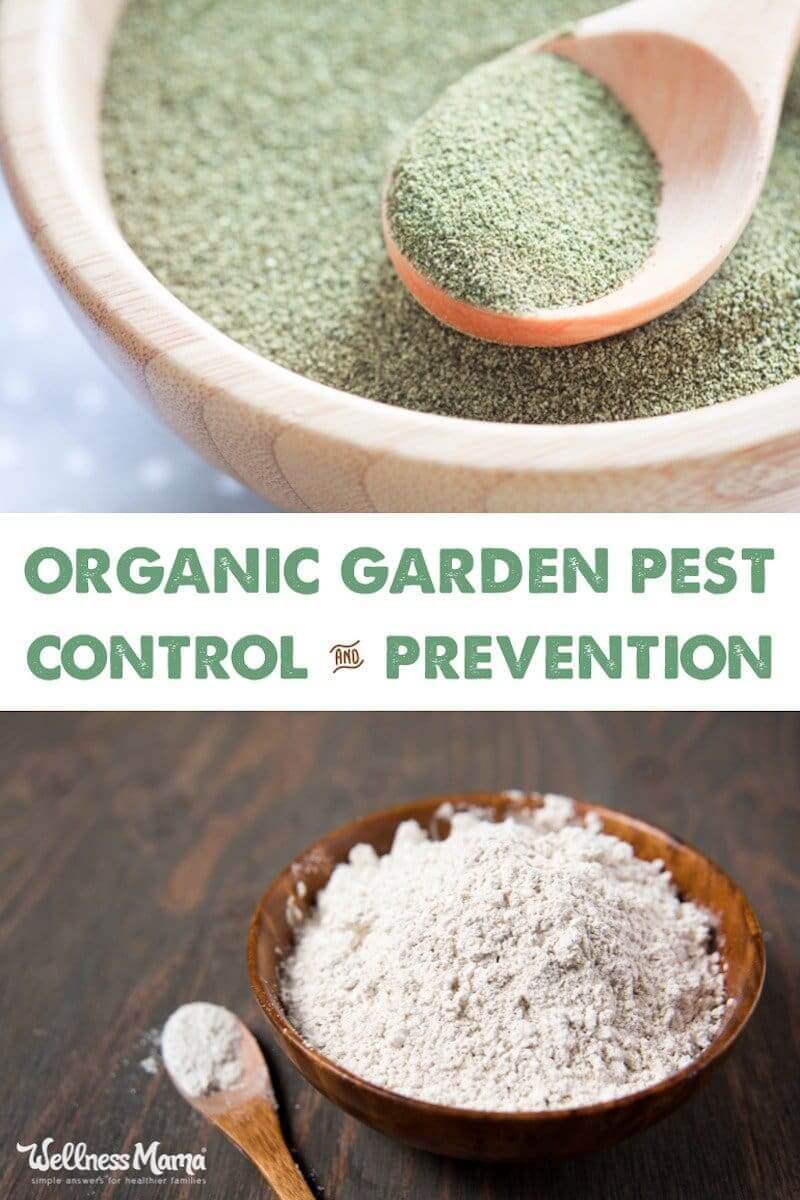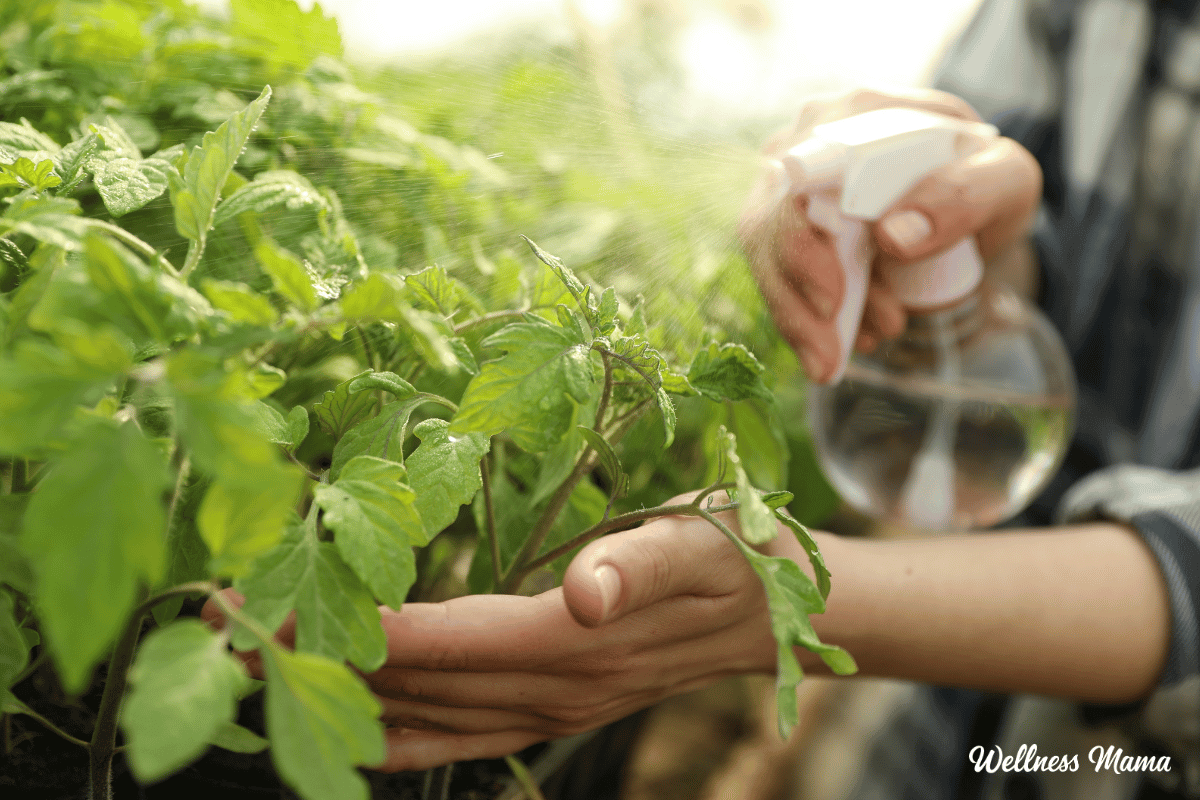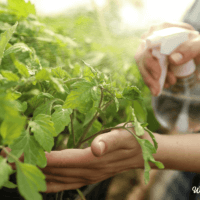Gardening can be a great way to save money and eat the freshest food but also comes with its fair share of frustrations. From pest management to proper watering, there are a lot of factors involved, especially if you’re using organic methods to avoid synthetic pesticides. Here are some natural pesticide options so your body (and the environment!) will thank you!
Fortunately, there are several ways to wage war against pests without resorting to harmful pesticides and insecticides. Companion planting, proper spacing, and natural pest control methods help ensure a healthy garden.
The Battle of the Bug
Insecticides, herbicides, and other pesticides come with their fair share of problems. Side effects of exposure range from skin irritation to breathing problems (to death in extreme cases!) It depends on the pesticide being used and the person using it. Even if someone doesn’t have any immediate side effects it’s still getting onto the food we’re eating. Plus it gets into the soil, our water, and our environment.
Some organic gardeners simply swap synthetic pesticides with organic pesticides. But let’s look at the bigger picture first. Our backyard vegetable garden is a part of the overall ecosystem. Some bugs are helpful for plants (like pollinators and ladybugs) and we actually want them around. Botanical insecticides can sometimes also kill the good bugs.
Before pulling out the natural insecticide, here are some things to try first!
Organic Garden Pest Control: Is It Possible?
Controlling pests in the home garden is possible, but I’ll be honest… it takes some work! Nothing crushes your gardening dreams finding your cabbages chewed to bits overnight.
Step 1: Be Proactive!
Take the time to walk through the garden for 5 minutes every day. This is called “scouting.” Look at the plants, turn over the leaves, and check the soil for signs of pest damage — eggs, larvae, chewed leaves, etc.
If you see any damage signs, act immediately. And yes, if you really want an organic garden, that may mean hand-picking and even squishing bugs. I prefer the soapy bucket approach. If you find adult bugs or larvae that like to munch, remove them (or the leaf any eggs are attached to) and put them in a bucket of soapy water.
Hand-picking bugs and other pests out of the garden isn’t practical for a large-scale problem. But if you use the organic pest control steps above you’ll hopefully prevent out-of-control situations. Frequent and close observation means you’ll be ready before disaster strikes!
Step 2: Use Companion Planting
Some plants have natural properties that help others grow and deter pests when planted close by. Making use of these is a way to increase garden production and fit more plants into a smaller space. The following are a few popular companion plants:
- Basil – Basil planted with tomato improves production and flavor. It’s also good for peppers and has been said to repel mosquitoes. I plant basil throughout the garden for its aroma and beneficial properties.
- Borage – A great companion for tomatoes and cabbage as it repels both tomato hornworms and cabbage moths. It also helps strawberries and is beneficial to practically everything in the garden. I plant throughout.
- Chamomile – A great companion for cabbage, cucumbers, onions, and all the brassicas. It improves flavor and is a great herb to have on hand. It attracts beneficial insects and has delicate and beautiful flowers. Plus it makes a yummy calming tea!
- Dill – I like to plant this with cabbages, cucumbers, lettuce, and more. It improves flavor, helps repel pests, and is useful in making homemade pickles! Dill also attracts parasitic wasps that kill bugs like aphids and tomato worms. It can get pretty big so I plant in the middle of cucumber beds.
- Catnip – Planted near squash and cucumbers it repels squash bugs and aphids. Steep the dried leaves in a tea to help soothe the stomach, and spray the tea on plants as a pest control spray!
- Radishes – These can be planted throughout the garden and under plants like cucumbers to deter cucumber beetles.
- Marigolds – Planted throughout the garden these help prevent nematodes and repel pests. They’ll flower all summer as long as you keep pulling the dead flowers off.
- Nasturtiums – Another great companion flower to tomatoes, cucumbers, cabbage, and more. The flowers are edible and are great in salads. They benefit melons and squashes as well.
- Onions – These can be planted freely throughout the garden to deter pests from cabbage, broccoli, tomatoes, strawberries, peppers, cucumbers, and more. Intercropping a few with all of these plants can greatly reduce garden pests.
- Sunflowers – Great companions and beautiful throughout the garden. Plant with cucumbers, beans, and vining plants to provide a trellis. They’re hardy and a great trap crop for aphids and other pests. They typically produce plenty of their own seeds to use next year.
There are many other great companion plants. Check out this chart for some other ideas.
Step 3: Use Homemade Pesticides and Repellants
Companion planting is helpful, but if you’ve already planted and are having trouble with pests, some homemade insecticides can be helpful:
- Kelp tea helps deter Japanese beetles and aphids and nourishes plants. Spray once a week or so before and during infestation times.
- A garlic and hot pepper spray (see recipe below) repels many garden insects and wildlife pests. It’s probably the most inexpensive option to make at home and isn’t harmful to you while applying. Use once a week or more for several weeks before and during infestation times.
- Lemon balm tea repels squash bugs and aphids. Apply 2 or more times a week as needed.
- A few teaspoons of baking soda in water can help prevent and treat fungus and powdery mildew on plants. Use as a preventative and acute treatment as needed.
Hot Pepper Garden Pest Spray Recipe
Materials
- 2-4 cloves garlic
- 4 cayenne peppers (or hotter peppers)
- 2 TBSP olive oil (or other liquid oil)
- 1 TBSP Castile soap
- 2-3 cups hot water
Instructions
- Put garlic, peppers, oil, soap, and water in a blender and blend on high for several minutes.
- Leave in a bowl or pitcher overnight or for at least 12 hours to intensify the effects of the garlic and peppers.
- Strain through a towel, cheesecloth, or strainer and store in a glass jar.
- To use, pour about 2 Tablespoons into a 16-ounce spray bottle (or 3 TBSP in a 24-ounce) and shake well.
- Spray directly on plants as needed… I recommend wearing gloves!
- Use as often as needed for preventative and pest-controlling effects.
Notes
Diatomaceous Earth
Diatomaceous earth is a good all-purpose prevention and treatment for any insect pests. Use with caution as it kills indiscriminately. I use DE mainly if I see slugs, snails, fleas, or insect larvae on plants, as it’s especially effective on these. Just sprinkle on plants as needed and reapply after watering or rain.
I buy food-grade DE and also use it for indoor pests like ants and as an internal cleanse for parasites in humans and animals. This is the brand we use.
Homemade Soap Spray Recipes
Another natural pesticide option is simply spraying soapy water on the bugs. You don’t want to use dish soap though as it can harm plants. Instead, opt for pure castile soap. If you use the type with added peppermint essential oil it also helps to ward off opportunistic insects!
- To make insecticidal soap spray use 1/4 teaspoon (or up to 1 Tablespoon) of castile liquid soap for every quart of water. Spray this directly on bugs to help break down their exoskeleton.
- You can also make a soap and oil spray that some consider to work better than soap alone. Use 1 teaspoon of castile soap to 1/3 cup of oil and mix well to make your soapy spray base. Use 1-2 teaspoons of this per 1 cup of water in a sprayer.
Test a small spot on the plant before you soak all of the leaves. Plants like beans, cucumbers, and peas do not like soap spray. This spray helps kill the following pests:
- Mites
- Aphids
- Thrips
- Scale insects
- Whiteflies
- Leafhoppers
- Mealybugs
Store Bought Natural Pesticides
If you prefer to buy something more garden centers have organic pesticides available. Neem oil sprays are an increasingly popular pest control option. It comes from the neem tree which has a long history of use in warding off pests and as a fungicide to attack mildew. It’s also biodegradable and won’t harm birds and pollinators.
The cheapest way to buy it is as a concentrate and mix it with water yourself. If you can’t find some locally you can get it online here.
Another organic pesticide option is pyrethrum spray. It’s a stronger pesticide naturally produced by chrysanthemum flowers. While pyrethrum has been used since the 1800s, newer versions often use synthetic pyrethrins, the active ingredients in the flowers. These synthetic versions are more toxic and stick around longer in the environment.
While it is a heavy hitter and technically safe for organic gardening, there are safer natural pesticide options.
Step 4: Help Plants Stay Healthy by Fertilizing
Strong plants resist unwanted bugs more easily. Growing strong and healthy plants is an important step in protecting your garden from pests.
- Kelp tea is not only a great way to naturally control garden pests, but it’s also a great foliar spray. Spray it on the leaves to nourish your plants (just don’t spray during the heat of the day). Sprinkling powdered kelp around plants can also have a nourishing effect.
- Nettle tea is another plant-nourishing option to spray on plants. You can also add dried nettle leaves directly to the soil or compost.
- Yarrow flower tea adds extra nutrients to plants. Use it to water your plants with. You can also sprinkle yarrow flowers throughout the garden which are said to have a pest-repelling effect.
- Fish emulsion is a natural fertilizer that can be sprayed on the leaves of plants to help promote growth. It’s especially good for tomatoes. It smells awful but is very effective!
- Bone and blood meal (like this) are high in nitrogen and very fertilizing to plants. Organic options are available and can be great if you are comfortable using them.
Step 5: Use Row Covers
Many flying pests see your garden as their ideal egg-laying station! Keep moths and other bugs from landing on your plants by using row covers. Floating row covers (fabric stretched over wire hoops) let light and water through but keep out pests who want to devour your precious produce.
Row covers are quite practical in small gardens and even extend the growing season a bit. It isn’t necessary to cover everything, but particularly vulnerable crops like potatoes, squash, and cabbage will benefit. They help protect against caterpillars, cabbage moths, and cabbage worms.
Netted covers can also help protect against squash borers. Just keep the covers on until the squash blossoms come in to deter borers.
Bottom Line on Natural Pesticides
It takes a little more work and planning, but it’s very possible to garden without toxic pesticides. The most important thing is to be observant so pests don’t have a chance to take over. The tasty (and healthy!) food you grow is well worth it!
Do you garden organically? What are your best tips and tricks for garden pest control?




Leave a Reply